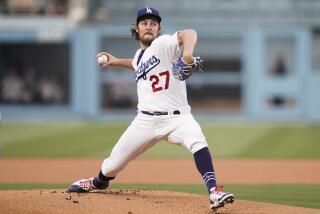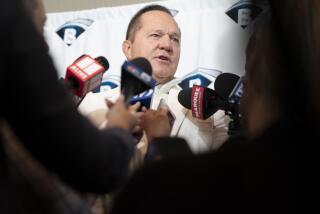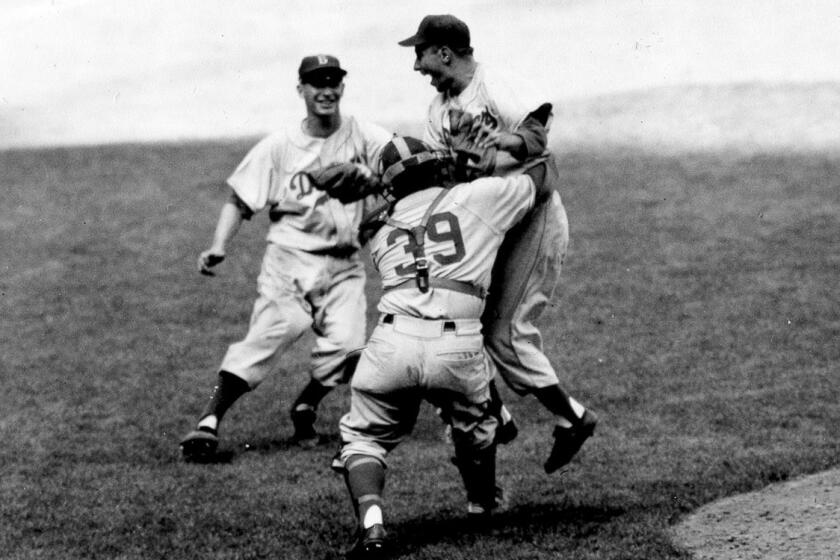On With the Show
NEW YORK — When it came down to it, when Bud Selig and Don Fehr and their negotiating staffs stared into the abyss of baseball’s ninth work stoppage in 30 years, it wasn’t so much that either side blinked.
It wasn’t so much that either side finally pushed the other over the edge in the holy pursuit of total victory.
This was sweeter than that, better for both, and certainly more productive for the game and their relationship.
How it plays out, what impact the new bargaining agreement has on competitive balance and the payroll structure remains to be seen, but give them credit.
Peace is better than war, and in avoiding a work stoppage for the first time in baseball’s combustible labor history, both sides identified the risks in doing otherwise.
The result was that a union conditioned to sweeping the owners agreed to the types of concessions, some larger than others, it would have considered--and still does to an extent--abhorrent in other years.
And the owners, who normally pursue total victory, only to capitulate at the 11th hour and be left with nothing, accepted incremental gains they can possibly build on in the next negotiations.
“We had significant differences, no question about it,” union counsel Gene Orza said, “but the key to this negotiation was that the clubs did not approach it with a provocative or authoritative stance. That was the one distinguishing feature.”
Perhaps, but more than the men who set the tone and did the negotiating, the strike-day settlement might have germinated in the accompanying environment.
It might have been the events surrounding these negotiations that conspired to produce--or at least contribute to--the changes in attitude and atmosphere.
A work stoppage by millionaire players and billionaire owners amid the nation’s reeling economy and attendance already down 6%?
Empty ballparks devoid of patriotic ceremonies on Sept. 11?
Ballplayers averaging $2.4 million having garbage and coins thrown at them, poster boys for greed?
Look, no one should be so naive as to think money didn’t play into the urgency to reach a settlement.
There was pressure from those bankers wanting loans repaid, and pressure from Fox concerned about postseason ad revenue.
Players would have lost about $335 million in salaries if the final 431 games had been canceled.
Owners might have lost $400 million in attendance and other revenue.
Dollars, as always, were a compelling factor, but so was sense, for a change.
Maybe that’s why they kept talking even after Fehr had had a couple of his usual verbal blowups at the table--union lawyers Steve Fehr, Michael Weiner and Orza were pivotal in keeping the process moving.
Maybe that’s why nobody quit even when the talks were causing sleepless nights and prompting lead management lawyer Rob Manfred to run to catch the last train from Grand Central long after midnight so that he could get home for a quick shower and be back in time for a breakfast of bargaining.
“It’s a different world than it was in 1994,” veteran player agent Tom Reich said, referring to the 232-day work stoppage of 1994-95.
“Anybody who couldn’t see the risk of permanent damage with another stoppage had to be blind, and neither side was.
“They should be complimented. They knew the sport couldn’t afford, maybe even survive, another shutdown and they negotiated a very even-handed agreement.”
Even-handed is one thing. Meaningful is another.
Of the major components, only time will determine if the increase in revenue sharing will be employed by recipient owners to close the competitive gap or wind up in their pockets, as that dole often has, to enhance their balance sheets and franchise values. The payroll tax and steroid testing could be similar illusions.
The tax is strictly what it is designed to be, a Yankee tax.
In the long term, only New York figures to be consistently penalized.
Many of the big spenders have already begun policing themselves. Cleveland and Baltimore have already cut back, and Texas and the Dodgers may be next.
Steroid testing is strictly window dressing aimed at appeasing fans. It has no teeth.
Random testing kicks in only if survey testing shows that more than 5% of the players are using steroids.
The first survey test is in the spring. Players know it’s coming and would have to be suffering from too many beanings to be on a spring cycle.
This was all about public relations for both sides, and the owners, who like to market bulked-up athletes hitting the ball out of the park, didn’t want it any more than the union did.
With all of that, the union can boast that it negotiated on issues it has previously refused to negotiate. That allowed Selig to emerge with almost all of the components recommended two years ago by his economic study committee and to announce for the cameras that the agreement should significantly contribute to restoring competitive balance.
Hard-line owners may believe it doesn’t go far enough and isn’t tough enough on salary growth, but it figures to be ratified, and it figures to contribute to a measure of previously missing stability.
If it also should not have come down to the 11th hour and a union strike date, the commissioner has to stand before the cameras on that as well.
If he had not called off secret negotiations with the union during mid-summer of 2001, withdrawn Paul Beeston’s negotiating authority, later forcing him to resign as baseball’s chief operating officer, and then wasted the off-season and much of 2002 on the doomed idea of deleting two teams, maybe it could have been resolved long before the uncertainty and all-night bargaining sessions that disrupted the division races.
What’s done is done, of course, and that’s the one, verifiable certainty about the new labor agreement.
More important than what’s in it, or the environmental and contributing factors in how the owners and players made it happen, it’s done.
And that’s a lot nicer than the customary abyss.
*
(BEGIN TEXT OF INFOBOX)
The New Deal
Players and owners negotiated a collective bargaining agreement covering four years that includes for the first time a payroll tax. The tax starts next season on teams with payrolls exceeding $117 million, and increases to a threshold of $136.5 million in 2006. Other highlights of the deal included:
* increased revenue sharing;
* drug testing for steroids;
* no reduction in the number of teams through the 2006 season;
* an increase in the minimum salary to $300,000 (up from $200,000);
For the full agreement, see D4.
More to Read
Are you a true-blue fan?
Get our Dodgers Dugout newsletter for insights, news and much more.
You may occasionally receive promotional content from the Los Angeles Times.









